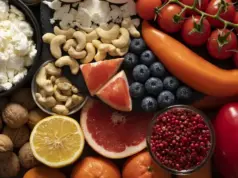Our bodies require fat as a sort of food for a number of purposes, including insulation, cushioning, and energy storage. It is one of the three macronutrients, together with proteins and carbs, that make up our diet. Lipids, sometimes referred to as fats, are formed of fatty acid molecules. The classification of fatty acids—as either saturated or unsaturated—determines the physical characteristics of the fat. Although our bodies require fat for a number of purposes, consuming too much of it can be harmful to our health. The risk of heart disease, stroke, and other illnesses can rise with a diet heavy in saturated and trans fats. As a result, it is advised to eat fats in moderation.
Types of Fats
Based on their chemical composition and physical characteristics, the various types of fats can be divided into different groups. Saturated, unsaturated, and trans fats are the three basic categories of fat.
- Saturated fats: Usually found in animal products like meat, butter, cheese, and cream, these fats are solid at room temperature. Some plant-based sources, such as coconut and palm oil, also contain them. Due to its ability to raise LDL (bad) cholesterol levels in the blood, a diet high in saturated fats can increase the risk of heart disease.
- Unsaturated fats: Mainly found in plant-based foods including vegetable oils, nuts, seeds, and fatty fish, these fats are liquid at room temperature. Both monounsaturated and polyunsaturated fats fall under this additional division.
- Monounsaturated fats: Fats that only contain one double bond in their chemical structure are referred to as monounsaturated fats. Foods including olive oil, avocados, almonds, and seeds contain them.
- Polyunsaturated fats: Fats that have two or more double bonds in their chemical structure are referred to as polyunsaturated fats. They can be found in fatty fish, nuts, seeds, and some vegetable oils, among other foods. Polyunsaturated fatty acids such as omega-3 and omega-6 are vital for good health.
- Trans Fat: Trans fats are unsaturated fats that have undergone a process known as hydrogenation, which makes them more stable and solid at room temperature. They can frequently be discovered in processed meals including baked goods, fried foods, and snack foods. The risk of heart disease and other health issues can arise with a diet heavy in trans fats.
Not all fats are created equal, therefore it’s vital to remember that eating a balanced diet of healthy fats can be good for our health. It is advised that we choose unsaturated fats and minimise our consumption of saturated and trans fats.
Functions of Fat
Adipose tissue, usually referred to as fat, serves a number of crucial roles in the human body. Some of these tasks consist of:
- Energy Storage: The body’s main source of energy storage is fat. Overeating results in the storage of extra energy in the form of fat cells for later usage.
- Insulation: Fat acts as insulation, assisting in the regulation of body temperature and preserving our body heat in chilly climates.
- Protection: Fat acts as an insulating and protective covering for the body’s organs and other structures.
- Regulation of hormones: Adipose tissue produces hormones including leptin and adiponectin that control insulin sensitivity, metabolism, and hunger.
- Absorption of fat-soluble vitamins: Vitamins that are soluble in fat, such as vitamins A, D, E, and K, must be absorbed in order to function.
- Source of essential fatty acids: Fat contains important fatty acids that the body requires but cannot manufacture on its own, such as omega-3 and omega-6 fatty acids.
It is crucial to remember that having too much body fat can result in conditions like obesity, cardiovascular disease, and type 2 diabetes. Therefore, it’s crucial to keep your body fat levels in check.
The sources of fats in your diet
The essential elements required for optimum health can be found in a variety of dietary sources. These consist of:
- Fruits and vegetables: These are great sources of antioxidants, fibre, vitamins, and minerals. They ought to constitute a sizable percentage of a balanced diet.
- Whole grains: Brown rice, quinoa, and whole wheat are examples of whole grains that are rich in fibre, vitamins, and minerals.
- Lean sources of protein: These include fish, poultry, eggs, lentils, lean meats, and tofu. These offer the vital amino acids that the body requires for repair and growth.
- Dairy products: Milk, yoghurt, and cheese are examples of low-fat dairy products that are good sources of calcium, vitamin D, and other essential elements.
- Nuts and seeds: These are a good source of fibre, protein, healthy fats, and critical vitamins and minerals.
- Fats and oils: Olive oil, avocados, and nuts are all fantastic sources of healthy fats. These foods include vital fatty acids and can be a good source of energy.
- Water: Water is vital for numerous bodily functions, including hydration.
Eating a range of foods from each of these sources is crucial to ensuring that the body receives all the nutrients it requires.
Conclusion
In summary, maintaining excellent health and preventing chronic diseases require a healthy and balanced diet. The body needs a number of nutrients, which can be supplied from a variety of food sources, including carbs, protein, fats, vitamins, and minerals. Additionally, it’s crucial to consume things in moderation and to avoid eating too many processed or high-fat foods. People can enhance their general health and well-being and lower their chance of contracting chronic diseases by eating a good, balanced diet.













































